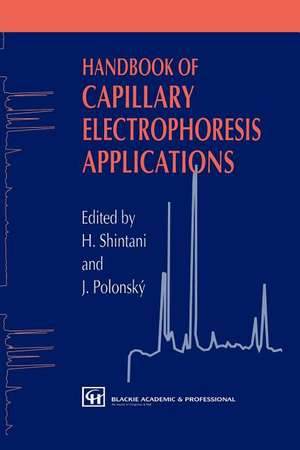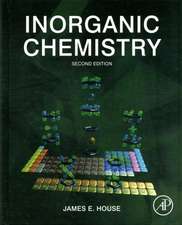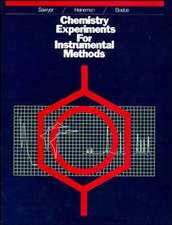Handbook of Capillary Electrophoresis Applications
Autor H. Shintani Editat de J. Polonskien Limba Engleză Paperback – 28 sep 2011
The book is written by an international team of authors, drawn from both academic and industrial users, and the manufacturers of instruments. At its heart are a number of tables, divided into specific application areas. These give details of published separations of a wide range of archetypal analytes, the successful separation conditions and the matrix in which they were presented. These tables are based on separations reported since 1992 and are fully referenced to the original literature. The tables are supported by discussions of the problems that a particular area presents and the strategies and solutions adopted to overcome them. The general areas covered are biochemistry, pharmaceutical science, bioscience, ion analysis, food analysis and environmental science.
| Toate formatele și edițiile | Preț | Express |
|---|---|---|
| Paperback (1) | 1837.88 lei 6-8 săpt. | |
| SPRINGER NETHERLANDS – 28 sep 2011 | 1837.88 lei 6-8 săpt. | |
| Hardback (1) | 1844.67 lei 6-8 săpt. | |
| SPRINGER NETHERLANDS – 31 dec 1996 | 1844.67 lei 6-8 săpt. |
Preț: 1837.88 lei
Preț vechi: 2241.32 lei
-18% Nou
Puncte Express: 2757
Preț estimativ în valută:
351.67€ • 367.18$ • 291.06£
351.67€ • 367.18$ • 291.06£
Carte tipărită la comandă
Livrare economică 05-19 aprilie
Preluare comenzi: 021 569.72.76
Specificații
ISBN-13: 9789401071970
ISBN-10: 9401071977
Pagini: 764
Ilustrații: XXIV, 738 p.
Dimensiuni: 155 x 235 x 40 mm
Greutate: 1.05 kg
Ediția:1997
Editura: SPRINGER NETHERLANDS
Colecția Springer
Locul publicării:Dordrecht, Netherlands
ISBN-10: 9401071977
Pagini: 764
Ilustrații: XXIV, 738 p.
Dimensiuni: 155 x 235 x 40 mm
Greutate: 1.05 kg
Ediția:1997
Editura: SPRINGER NETHERLANDS
Colecția Springer
Locul publicării:Dordrecht, Netherlands
Public țintă
ResearchCuprins
I.1 Electroosmotic flow (EOF) and analyte mobilization.- I.2 Separation modes and samples.- References.- One Equipment Systems.- 1 Sample injection.- 2 Quantitative analysis, precision and reproducibility.- 3 Precision and quantitation in capillary electrophoresis.- 4 Column technology.- 5 Electrolyte systems.- 6 Detection.- 7 Recent advances in fluorescence detection technology.- 8 Other systems.- 9 Advanced systems.- 10 Automated fraction collection in capillary electrophoresis.- 11 Comparison with other analytical methods.- Two Biochemistry Applications.- 12 Amino acids.- 13 Sodium dodecyl sulfate (SDS)-non-gel molecular sieving capillary electrophoresis for proteins.- 14 Protein analysis by capillary electrophoresis.- 15 Analysis of erythropoietin by capillary electrophoresis.- 16 Assay of enzymes by capillary electrophoresis.- 17 Capillary electrophoresis-based immunoassays.- 18 Analysis of antibodies by capillary electrophoresis.- 19 Analysis of peptide hormones and model peptides by capillary electrophoresis.- 20 Affinity analysis by capillary electrophoresis.- 21 Analysis of nucleic acids by capillary electrophoresis.- Three Pharmaceutical Science Applications.- 22 Analysis of pharmaceuticals by capillary electrophoresis.- 23 Analysis of medicinal plants: comparison of capillary electrophoresis with high performance liquid chromatography.- 24 Quantitative applications of the resolution of enantiomers by capillary electrophoresis.- 25 Applications of chiral capillary electrophoresis (cyclodextrin-capillary zone electrophoresis; CD-CZE).- 26 Separation of enantiomeric compounds by micelle-mediated capillary electrokinetic chromatography.- 27 Therapeutic drug monitoring by capillary electrophoresis.- Four Bioscience Applications.- 28 Biomedical applications and biological systems.- 29 Analysis of selected common clinical tests by capillary electrophoresis.- 30 Gene analysis and nucleic acid sequencing.- 31 Gene mutation and DNA sequencing.- 32 Analysis of body fluids: urine, blood, saliva and tears.- 33 Toxins associated mainly with uremia and cancer.- Five Ion Analysis Applications.- 34 Capillary electrophoresis of metal complexes.- 35 Metal chelation.- 36 Inorganic ions.- 37 Organic acids and organic ions.- Six Food Analysis Applications.- 38 Food analysis by capillary electrophoresis.- 39 Capillary zone electrophoresis analysis of additives in food samples.- 40 Analysis of underivatized carbohydrates by capillary electrophoresis and electrochemical detection.- Seven Environmental Science Applications.- 41 Hydrocarbons.- 42 Environmental pollutants.- 43 Analysis of synthetic polymers by capillary electrophoretic techniques.- Appendix A Commercially available instrumentation for capillary electrophoresis.- Appendix A1 Overview of commercial instruments T. Wehr and M. Zhu.- A1.1 Introduction.- A1.2 Power supply.- A1.3 Injection.- A1.4 Capillary temperature control.- A1.5 Liquid handling.- A1.6 Autosamplers.- A1.7 Detectors.- A1.7.1 UV-vis absorbance.- A1.7.2 Fluorescence.- A1.7.3 Other detectors.- A1.7.4 On-line coupling with mass spectrometry (MS).- A1.8 Fraction collection.- Appendix A2 The CAPI series of instruments K. Kitagishi.- A2.1 CAPI-3100.- A2.1.1 Specifications.- A2.1.2 Features.- A2.2 CAPI-1000.- A2.2.1 Specifications.- A2.2.2 Features.- Appendix B Troubleshooting K. Kitagishi.- Appendix C Commercially available buffer reagents H. Shintani.










